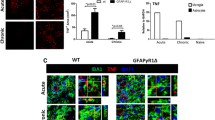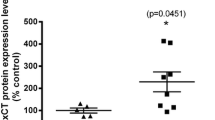Abstract
Evidence has emerged over recent years suggesting that trophic factors such as neurotrophic cytokines and neurotrophins may play an important role in multiple sclerosis (MS) and its animal model, experimental autoimmune encephalomyelitis (EAE). In mice that lack the neurotrophic cytokine ciliary neurotrophic factor (CNTF), EAE is more severe, suggesting that this molecule may normally contribute to protection of the nervous system from an inflammatory attack. The axonoprotective neurotrophin brain derived neurotrophic factor (BDNF) is not only expressed in immune cells in vitro, but also in MS lesions. Thus, infiltrating immune cells in the central nervous system (CNS) may not only be detrimental, but may also exert a protective effect, a concept referred to as “neuroprotective autoimmunity” Yet, the functional relevance of BDNF during CNS inflammation has not been definitely elucidated so far. BDNF knockout mice die prematurely and thus cannot be investigated in models of autoimmune demyelination. The analysis of recently developed conditional knockout mice with a selective suppression of BDNF production in different subsets of immune cells may improve our understanding of the role of this neurotrophin during autoimmunity of the CNS.
Similar content being viewed by others
References
Aharoni R, Eilam R, Domev H, Labunskay G, Sela M, Arnon R (2005) The immunomodulator glatiramer acetate augments the expression of neurotrophic factors in brains of experimental autoimmune encephalomyelitis mice. Proc Natl Acad Sci USA 102:19045-9050
Aharoni R, Teitelbaum D, Sela M, Arnon R (1998) Bystander suppression of experimental autoimmune encephalomyelitis by T cell lines and clones of the Th2 type induced by copolymer 1. J Neuroimmunol 91:135-46
Altieri M, Marini F, Arban R, Vitulli G, Jansson BO (2004) Expression analysis of brain-derived neurotrophic factor (BDNF) mRNA isoforms after chronic and acute antidepressant treatment. Brain Res 1000:148-55
Barres BA, Burne JF, Holtmann B, Thoenen H, Sendtner M, Raff MC (1996) Ciliary neurotrophic factor enhances the rate of oligodendrocyte generation. Mol Cell Neurosci 8:146-56
Besser M, Wank R (1999) Cutting edge: clonally restricted production of the neurotrophins brain-derived neurotrophic factor and neurotrophin-3 mRNA by human immune cells and Th1/Th2-polarized expression of their receptors. J Immunol 162:6303-306
Bravo J, Heath JK (2000) Receptor recognition by gp130 cytokines. EMBO J 19:2399-411
Butzkueven H, Emery B, Cipriani T, Marriott MP, Kilpatrick TJ (2006) Endogenous leukemia inhibitory factor production limits autoimmune demyelination and oligodendrocyte loss. Glia 53:696-03
Butzkueven H, Zhang JG, Soilu-Hanninen M et al. (2002) LIF receptor signaling limits immune-mediated demyelination by enhancing oligodendrocyte survival. Nat Med 8:613-19
Chen M, Valenzuela RM, Dhib-Jalbut S (2003) Glatiramer acetate-reactive T cells produce brain-derived neurotrophic factor. J Neurol Sci 215:37-4
Clausen BE, Burkhardt C, Reith W, Renkawitz R, Forster I (1999) Conditional gene targeting in macrophages and granulocytes using LysMcre mice. Transgenic Res 8:265-77
Dittrich F, Thoenen H, Sendtner M (1994) Ciliary neurotrophic factor: pharmacokinetics and acute-phase response in rat. Ann Neurol 35:151-63
D'Souza SD, Alinauskas KA, Antel JP (1996) Ciliary neurotrophic factor selectively protects human oligodendrocytes from tumor necrosis factor-mediated injury. J Neurosci Res 43:289-98
Emery B, Cate HS, Marriott M et al. (2006) Suppressor of cytokine signaling 3 limits protection of leukemia inhibitory factor receptor signaling against central demyelination. Proc Natl Acad Sci USA 103:7859-864
Farina C, Weber MS, Meinl E, Wekerle H, Hohlfeld R (2005) Glatiramer acetate in multiple sclerosis: update on potential mechanisms of action. Lancet Neurol 4:567-75
Giess R, Maurer M, Linker R, Gold R, Warmuth-Metz M, Toyka KV, Sendtner M, Rieckmann P (2002) Association of a null mutation in the CNTF gene with early onset of multiple sclerosis. Arch Neurol 59:407-09
Giess R, Tanasescu I, Steck T, Sendtner M (1999) Leukaemia inhibitory factor gene mutations in infertile women. Mol Hum Reprod 5:581-86
Gold R, Linington C, Lassmann H (2006) Understanding pathogenesis and therapy of multiple sclerosis via animal models: 70 years of merits and culprits in experimental autoimmune encephalomyelitis research. Brain 129:1953-971
Gold R, Zielasek J, Schroder JM, Sellhaus B, Cedarbaum J, Hartung HP, Sendtner M, Toyka KV (1996) Treatment with ciliary neurotrophic factor does not improve regeneration in experimental autoimmune neuritis of the Lewis rat. Muscle Nerve 19:1177-180
Gossen M, Bujard H (1992) Tight control of gene expression in mammalian cells by tetracycline-responsive promoters. Proc Natl Acad Sci USA 89:5547-551
Hauben E, Nevo U, Yoles E et al. (2000) Autoimmune T cells as potential neuroprotective therapy for spinal cord injury. Lancet 355:286-87
Hoffmann V, Pohlau D, Przuntek H, Epplen JT, Hardt C (2002) A null mutation within the ciliary neurotrophic factor (CNTF)-gene: implications for susceptibility and disease severity in patients with multiple sclerosis. Genes Immun 3:53-5
Hohlfeld R, Kerschensteiner M, Stadelmann C, Lassmann H, Wekerle H (2000) The neuroprotective effect of inflammation: implications for the therapy of multiple sclerosis. J Neuroimmunol 107:161-66
Kasarskis EJ, Shefner JM, Miller R et al. (1999) A controlled trial of recombinant methionyl human BDNF in ALS. Neurology 52:1427-433
Kernie SG, Liebl DJ, Parada LF (2000) BDNF regulates eating behavior and locomotor activity in mice. EMBO J 19:1290-300
Kerr BJ, Patterson PH (2005) Leukemia inhibitory factor promotes oligodendrocyte survival after spinal cord injury. Glia 51:73-9
Kerschensteiner M, Gallmeier E, Behrens L (1999) Activated human T cells, B cells, and monocytes produce brain-derived neurotrophic factor in vitro and in inflammatory brain lesions: a neuroprotective role of inflammation? J Exp Med 189:865-70
Kerschensteiner M, Stadelmann C, Dechant G, Wekerle H, Hohlfeld R (2003) Neurotrophic cross-talk between the nervous and immune systems: implications for neurological diseases. Ann Neurol 53:292-04
Korte M, Carroll P, Wolf E, Brem G, Thoenen H, Bonhoeffer T (1995) Hippocampal long-term potentiation is impaired in mice lacking brain-derived neurotrophic factor. Proc Natl Acad Sci USA 92:8856-860
Kruse, N, Cetin S, Chan, A, Gold R, Luhder F (2007) Differential expression of BDNF mRNA splice variants in mouse brain and immune cells. J Neuroimmunol 182:113-19
Kuhlmann T, Remington L, Cognet I et al. (2006) Continued administration of ciliary neurotrophic factor protects mice from inflammatory pathology in experimental autoimmune encephalomyelitis. Am J Pathol 169:584-98
Levi-Montalcini R, Skaper S, Dal Tosco R, Petrelli L, Leon A (1996) Nerve growth factor: from neurotrophin to neurokine. Trends Neurosci 19:514-20
Lewin GR (1996) Neurotrophins and the specification of neuronal phenotype. Philos Trans R Soc Lond B Biol Sci 351:405-11
Linker RA, Maurer M, Gaupp S et al. (2002) CNTF is a major protective factor in demyelinating CNS disease: a neurotrophic cytokine as modulator in neuroinflammation. Nat Med 8:620-24
Linker RA, Sendtner M, Gold R (2005) Mechanisms of axonal degeneration in EAE-lessons from CNTF and MHC I knockout mice. J Neurol Sci 233:167-72
Liu QR, Lu L, Zhu XG, Gong JP, Shaham Y, Uhl GR (2006) Rodent BDNF genes, novel promoters, novel splice variants, and regulation by cocaine Brain Res 1067:1-2
Louis JC, Magal E, Takayama S, Varon S (1993) CNTF protection of oligodendrocytes against natural and tumor necrosis factor-induced death. Science 259:689-92
MacDonald SC, Simcoff R, Jordan LM, Dodd JG, Cheng KW, Hochman S (2002) A population of oligodendrocytes derived from multipotent neural precursor cells expresses a cholinergic phenotype in culture and responds to ciliary neurotrophic factor. J Neurosci Res 68:255-64
Maroder M, Bellavia D, Meco D et al. (1996) Expression of trKB neurotrophin receptor during T cell development. Role of brain derived neurotrophic factor in immature thymocyte survival. J Immunol 157:2864-872
Masu Y, Wolf E, Holtmann B, Sendtner M, Brem G, Thoenen H (1993) Disruption of the CNTF gene results in motor neuron degeneration. Nature 365:27-2
Mayer M, Bhakoo K, Noble M (1994) Ciliary neurotrophic factor and leukemia inhibitory factor promote the generation, maturation and survival of oligodendrocytes in vitro. Development 120:143-53
McAllister AK (2000) Cellular and molecular mechanisms of dendrite growth. Cereb Cortex 10:963-73
Moalem G, Gdalyahu A, Shani Y, Otten U, Lazarovici P, Cohen IR, Schwartz M (2000) Production of neurotrophins by activated T cells: implications for neuroprotective autoimmunity. J Autoimmun 15:331-45
Moalem G, Leibowitz-Amit R, Yoles E, Mor F, Cohen IR, Schwartz M (1999) Autoimmune T cells protect neurons from secondary degeneration after central nervous system axotomy. Nat Med 5:49-5
Nockher WA, Renz H (2006) Neurotrophins in allergic diseases: from neuronal growth factors to intercellular signaling molecules. J Allergy Clin Immunol 117:583-89
Ohara O, Gahara Y, Teraoka H, Kitamura T (1992) A rat brain-derived neurotrophic factor-encoding gene generates multiple transcripts through alternative use of 5' exons and polyadenylation sites. Gene 121:383-86
Ransohoff RM, Howe CL, Rodriguez M (2002) Growth factor treatment of demyelinating disease: at last, a leap into the light. Trends Immunol 23:512-16
Sauer B (2002) Cre/lox: one more step in the taming of the genome. Endocrine 19:221-28
Schuhmann B, Dietrich A, Sel S et al. (2005) A role for brain-derived neurotrophic factor in B cell development. J Neuroimmunol 163:15-3
Schuster B, Kovaleva M, Sun Y et al. (2003) Signaling of human ciliary neurotrophic factor (CNTF) revisited. The interleukin-6 receptor can serve as an alpha-receptor for CTNF. J Biol Chem 278:9528-535
Schwartz M, Kipnis J (2005) Protective autoimmunity and neuroprotection in inflammatory and noninflammatory neurodegenerative diseases. J Neurol Sci 233:163-66
Schwartz M, Kipnis (2001) Protective autoimmunity: regulation and prospects for vaccination after brain and spinal cord injuries. Trends Mol Med 7:252-58
Sendtner M, Stockli KA, Thoenen H (1992) Synthesis and localization of ciliary neurotrophic factor in the sciatic nerve of the adult rat after lesion and during regeneration. J Cell Biol 118:139-48
Stadelmann C, Kerschensteiner M, Misgeld T, Bruck W, Hohlfeld R, Lassmann H (2002) BDNF and gp145trkB in multiple sclerosis brain lesions: neuroprotective interactions between immune and neuronal cells? Brain 125:75-5
Stankoff B, Aigrot MS, Noel F, Wattilliaux A, Zalc B, Lubetzki C (2002) Ciliary neurotrophic factor (CNTF) enhances myelin formation: a novel role for CNTF and CNTF-related molecules. J Neurosci 22:9221-227
Takahashi R, Yokoji H, Misawa H, Hayashi M, Hu J, Deguchi T (1994) A null mutation in the human CNTF gene is not causally related to neurological diseases. Nat Genet 7:79-4
Taupin JL, Pitard V, Dechanet J, Miossec V, Gualde N, Moreau JF (1998) Leukemia inhibitory factor: part of a large ingathering family. Int Rev Immunol 16:397-26
Tennakoon DK, Mehta RS, Ortega SB, Bhoj V, Racke MK, Karandikar NJ (2006) Therapeutic induction of regulatory, cytotoxic CD8+ T cells in multiple sclerosis. J Immunol 176:7119-129
Vanderlocht J, Hellings N, Hendriks JJ, Vandenabeele F, Moreels M, Buntinx M, Hoekstra D, Antel JP, Stinissen P (2006) Leukemia inhibitory factor is produced by myelin-reactive T cells from multiple sclerosis patients and protects against tumor necrosis factoralpha-induced oligodendrocyte apoptosis. J Neurosci Res 83:763-74
Watson FL, Heerssen HM, Moheban DB et al. (1999) Rapid nuclear responses to target-derived neurotrophins require retrograde transport of ligand-receptor complex. J Neurosci 19:7889-900
Wujek JR, Bjartmar C, Richer E, Ransohoff RM, Yu M, Tuohy VK, Trapp BD (2002) Axon loss in the spinal cord determines permanent neurological disability in an animal model of multiple sclerosis. J Neuropathol Exp Neurol 61:23-2
Ziemssen T (2004) Neuroprotection and glatiramer acetate: the possible role in the treatment of multiple sclerosis. Adv Exp Med Biol 541:111-34
Ziemssen T, Kumpfel T, Klinkert WE, Neuhaus O, Hohlfeld R (2002) Glatiramer acetate-specific T-helper 1- and 2-type cell lines produce BDNF: implications for multiple sclerosis therapy. Brain-derived neurotrophic factor. Brain 125:2381-391
Author information
Authors and Affiliations
Corresponding author
Rights and permissions
About this article
Cite this article
Linker, R., Lee, DH., Siglienti, I. et al. Is there a role for neurotrophins in the pathology of multiple sclerosis?. J Neurol 254 (Suppl 1), I33–I40 (2007). https://doi.org/10.1007/s00415-007-1007-8
Issue Date:
DOI: https://doi.org/10.1007/s00415-007-1007-8




